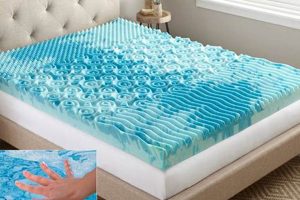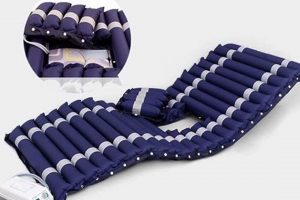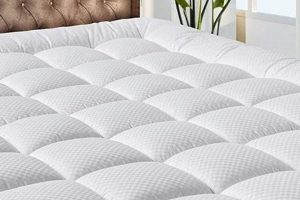The distinction between a thin layer of padding and a thicker addition to a bed is significant. The former primarily serves to protect the mattress surface from stains and minor wear, offering a minimal change to the feel of the bed. An example is a quilted fabric sheet secured with elastic straps at the corners. The latter, conversely, aims to alter the overall comfort level of the sleeping surface. Materials like memory foam or latex are common examples, designed to contour to the body or provide additional support.
Understanding the variations is crucial for optimizing sleep quality and extending the lifespan of the primary mattress. Selecting the appropriate bedding can address concerns such as overheating, pressure points, or inadequate support. Historically, simpler forms of bed coverings focused primarily on hygiene and protection; modern innovations have expanded their role to include enhanced sleep ergonomics and customized comfort solutions.
The following sections will delve into specific characteristics, detailing the construction, materials, and intended use cases for each category. The properties, advantages, and disadvantages of each will be examined to facilitate an informed decision-making process for consumers.
Tips for Choosing Between Bedding Options
Selecting the correct bedding enhancement requires careful consideration of individual sleep needs and existing mattress characteristics. The following tips provide a framework for evaluating options and making an informed choice.
Tip 1: Assess Current Mattress Condition: Before purchasing either option, evaluate the state of the existing mattress. If the mattress is nearing the end of its lifespan or exhibits significant sagging, neither product will provide a lasting solution. A replacement mattress may be necessary.
Tip 2: Define Desired Comfort Level: Clearly identify the specific comfort issues to be addressed. Is the mattress too firm, too soft, or simply lacking in pressure relief? The answer will dictate whether the subtle enhancement of one product or the more significant change provided by the other is appropriate.
Tip 3: Consider Material Properties: Different materials offer distinct benefits. Memory foam conforms to the body, while latex provides buoyant support. Cotton offers breathability, and wool regulates temperature. Choose materials that align with individual comfort preferences and any allergies.
Tip 4: Evaluate Thickness and Density: The thickness of bedding addition directly impacts its effect on mattress feel. Thicker options provide more significant contouring and support, while thinner options offer minimal alteration. Density affects durability and support; higher density materials generally last longer.
Tip 5: Account for Budget: Prices vary significantly based on materials, construction, and brand. Establish a realistic budget prior to shopping and prioritize essential features over non-essential ones.
Tip 6: Research Care Instructions: Cleaning and maintenance requirements differ among products. Consider ease of cleaning and overall durability when making a selection. Look for machine-washable or spot-cleanable options for convenience.
Understanding these considerations will improve decision-making and prevent purchasing an item that does not adequately meet sleep needs. Careful evaluation ensures an investment that contributes to improved sleep quality.
The following section will conclude by highlighting how to weigh the information and make the ideal choice based on specific needs and desires.
1. Protection vs. Comfort
The core difference between these bedding accessories hinges on their primary function: protection versus comfort enhancement. A mattress pad primarily serves to safeguard the mattress surface from stains, spills, and general wear. The contribution to sleep comfort is typically minimal, focusing instead on maintaining the integrity of the underlying mattress. For instance, a waterproof pad protects against accidental liquid damage, extending the mattress’s lifespan. Conversely, the chief aim of a mattress topper is to alter the feel of the sleep surface, providing added cushioning, support, or temperature regulation. A memory foam topper, for example, contours to the body, relieving pressure points and potentially improving sleep quality. Thus, the primary needpreservation or augmentationdictates the appropriate choice.
The distinction has practical significance in several scenarios. Individuals with new mattresses may prioritize protection to ensure warranty validity and prevent cosmetic damage. Families with young children or pets may find a waterproof pad essential for managing accidents. Alternatively, individuals experiencing discomfort due to a too-firm or too-soft mattress may opt for a topper to adjust the sleep surface without the expense of replacing the entire mattress. Further, the construction and materials reflect this divergence. Pads are often thinner and made from basic materials like cotton or polyester, while toppers incorporate materials known for their comfort properties, such as memory foam, latex, or down alternatives.
Ultimately, the relative importance of protection and comfort is a matter of personal preference and specific needs. Understanding this fundamental difference is the first step toward making an informed purchasing decision. While some products may offer a degree of both protection and comfort, one function will always be the dominant characteristic. Identifying the priority whether it’s shielding the investment in a mattress or enhancing the sleep experience narrows the options and simplifies the selection process. Failure to account for this essential dichotomy can lead to dissatisfaction and an ineffective bedding solution.
2. Thickness and Support
The attributes of thickness and support are paramount in differentiating these bedding options and significantly impact their functionality. The degree of thickness directly correlates with the level of support and contouring provided, thereby influencing sleep quality and overall comfort.
- Thickness as a Determinant of Impact
Thickness is a primary determinant of the degree to which either product can alter the feel of a mattress. Thicker options offer a more substantial change in firmness and contouring, while thinner options provide only a subtle modification. For example, a one-inch pad offers minimal cushioning, whereas a four-inch topper can significantly soften a firm mattress. The thickness directly translates to the degree of added support and pressure relief.
- Support Characteristics by Type
The supportive capabilities differ vastly. Mattress pads, typically thin, offer minimal structural support and are desig
ned primarily for surface protection. Conversely, toppers are often engineered with materials like memory foam or latex, which conform to the body, distributing weight and alleviating pressure points. An individual seeking enhanced spinal alignment and pressure relief would benefit more from a supportive topper than a basic pad. - Material Density and Durability
Thickness is closely linked to material density, which affects durability and longevity. Denser materials, often found in thicker toppers, provide greater resistance to compression and deformation over time. A high-density memory foam topper, for example, will retain its shape and supportive qualities longer than a low-density alternative. The initial investment in a thicker, denser option may yield long-term cost savings by delaying mattress replacement.
- Impact on Temperature Regulation
Thickness can also influence temperature regulation. Thicker bedding accessories may trap more heat, particularly if constructed from dense, non-breathable materials. Conversely, thinner options, or those made with breathable materials like wool or ventilated foam, may promote airflow and reduce overheating. Individuals prone to night sweats should consider the thermal properties of the material in relation to its thickness.
In conclusion, the thickness and support characteristics are key differentiators that dictate the suitability of either product for specific needs. Choosing involves carefully balancing the desired level of comfort modification, the required degree of support, and the potential impact on temperature regulation. The goal is to select an option that complements the existing mattress and promotes restful sleep.
3. Material Composition
The specific materials used in construction fundamentally differentiate mattress pads and mattress toppers, dictating their performance characteristics, durability, and suitability for various needs. The choice of material impacts factors such as support, temperature regulation, and hypoallergenic properties, directly affecting user experience.
- Surface Fabric and Fill Materials in Pads
Mattress pads commonly utilize a thin layer of fill material, such as cotton, polyester, or down alternatives, encased in a fabric shell. The shell is often cotton or a cotton blend. The fill primarily serves to provide a slight cushioning effect and a barrier against spills. For example, a pad with a polyester fill is inexpensive and easy to clean, but offers minimal support. In contrast, a down-filled pad provides greater softness but requires specialized cleaning and may not be suitable for individuals with allergies. The selection of surface and fill materials dictates the degree of protection and minimal comfort enhancement offered.
- Core Materials in Toppers
Toppers, designed for significant comfort modification, employ core materials such as memory foam, latex, or down. Memory foam conforms to the body, offering pressure relief and motion isolation. Latex provides a more responsive and buoyant feel, with natural latex offering enhanced breathability and durability. Down toppers offer plushness but may require frequent fluffing to maintain loft. The choice of core material is critical in determining the level of support, contouring, and temperature regulation provided.
- Consideration of Density and Thickness
The density and thickness of materials within each category further refine their performance characteristics. High-density memory foam in a topper provides greater support and longevity compared to a low-density alternative. Similarly, a thicker down topper will offer more cushioning than a thinner version. However, increased thickness can also impact heat retention, potentially causing discomfort for some users. Material density and thickness are intertwined, influencing support, durability, and temperature regulation.
- Impact on Hypoallergenic Properties and Maintenance
Material composition also influences hypoallergenic properties and ease of maintenance. Natural latex and tightly woven fabrics are inherently resistant to dust mites and allergens. Synthetic materials, such as polyester, are less prone to harboring allergens and are often machine washable. Down, while luxurious, can trigger allergies and requires professional cleaning. The choice of materials must consider individual sensitivities and the practicalities of cleaning and maintenance to ensure a healthy and sustainable sleep environment.
Ultimately, the distinction in material composition underscores the functional divergence. Mattress pads prioritize protection and basic comfort with simpler, often less expensive materials. Mattress toppers, conversely, focus on enhancing comfort and support through specialized materials engineered for specific performance characteristics. Careful consideration of individual needs, preferences, and potential sensitivities is essential in selecting the appropriate bedding enhancement based on its constituent materials.
4. Attachment Method
The method by which each bedding component is secured to the mattress is a defining characteristic contributing to the functional divergence between a mattress pad and a mattress topper. The attachment mechanism directly influences the stability, ease of use, and overall effectiveness of each product.
- Elastic Straps or Fitted Skirt Design
Mattress pads commonly employ elastic straps at the corners or a fitted skirt design, similar to a fitted sheet. This approach provides a relatively simple and inexpensive means of securing the pad to the mattress. However, the elastic may stretch over time, leading to slippage and requiring frequent readjustment. The fitted skirt design offers a more secure fit, but may not accommodate mattresses of varying thicknesses. The primary advantage is ease of installation and removal for cleaning or replacement. This method prioritizes convenience over a consistently secure attachment.
- Lack of Integrated Attachment Mechanisms
Some mattress toppers lack specific integrated attachment mechanisms. These toppers rely primarily on their weight and the friction between the materials to remain in place. This can lead to shifting and movement during sleep, particularly on slick mattress surfaces. The absence of a secure attachment system necessitates frequent repositioning and may diminish the topper’s effectiveness in providing consistent support and comfort. This passive attachment method often correlates with lower-cost toppers.
- Integrated Straps or Anchor Systems
Higher-end mattress toppers may incorporate integrated straps or anchor systems designed to provide a more secure and stable attachment to the mattress. These systems may include adjustable elastic straps that wrap around the mattress corners or non-slip materials on the underside of the topper. This approach minimizes shifting and ensures that the topper remains in the desired position throughout the night. Integrated attachment mechanisms are often indicative of a higher-quality product designed for long-term use.
- Impact on Maintenance and Cleaning
The attachment method also influences the ease of maintenance and cleaning. Mattress pads with elastic straps or a fitted skirt are easily remo
ved for washing. Toppers lacking secure attachment may be more difficult to handle and maneuver during cleaning. Integrated straps or anchor systems may require specific cleaning instructions to avoid damage. The practicalities of cleaning and maintenance should be considered when evaluating the attachment method.
In summation, the attachment method represents a key differentiating factor directly impacting the stability, ease of use, and maintenance of each. While simpler methods prioritize convenience, more robust systems ensure consistent performance and longevity. The choice depends on balancing the need for secure attachment with the practicalities of cleaning and handling.
5. Price Point
Price point serves as a significant differentiating factor between a mattress pad and a mattress topper, reflecting variations in materials, construction, and intended function. Mattress pads, designed primarily for surface protection, typically command a lower price due to their simpler construction and less expensive materials. A basic quilted pad, for example, may cost between $30 and $70 for a queen size. Conversely, mattress toppers, engineered for comfort enhancement and support, generally fall into a higher price bracket. A memory foam topper, depending on its thickness and density, can range from $100 to $500 or more for the same size. The increased investment reflects the higher-quality materials and more complex manufacturing processes involved.
The price difference directly correlates with the perceived value and expected performance of each product. A consumer seeking solely to protect a mattress from stains may find a lower-priced pad adequate. However, an individual desiring to alleviate pressure points or adjust the firmness of the sleep surface will likely need to invest in a more expensive topper. The materials used, such as memory foam versus cotton, and the features offered, such as enhanced breathability or specialized construction, contribute to the overall cost. A higher price point often indicates a greater level of comfort, support, and durability, influencing the long-term value proposition. This differential pricing also impacts consumer expectations; individuals typically anticipate a greater level of performance and longevity from a more costly topper compared to a basic pad.
In summary, the price point serves as a key indicator of the functional differences between a mattress pad and a mattress topper. It reflects the materials used, the complexity of construction, and the intended purpose of each product. While a lower price may be attractive for budget-conscious consumers seeking basic protection, a higher price often signals enhanced comfort, support, and durability for those prioritizing sleep quality. Understanding this relationship allows for informed decision-making that aligns with individual needs and financial considerations.
Frequently Asked Questions
The following section addresses common inquiries regarding the distinctions between mattress pads and mattress toppers, providing clarity on their respective roles and benefits.
Question 1: What is the fundamental difference between a mattress pad and a mattress topper?
A mattress pad primarily serves to protect the mattress surface from stains and minor wear. A mattress topper alters the comfort level of the sleeping surface, adding cushioning or support.
Question 2: How does thickness differentiate a mattress pad from a mattress topper?
Mattress pads are typically thin, offering minimal change to the mattress feel. Mattress toppers are thicker, providing a more substantial alteration in firmness and support.
Question 3: What materials are commonly used in mattress pads versus mattress toppers?
Mattress pads often utilize cotton, polyester, or down alternatives. Mattress toppers commonly employ memory foam, latex, or down.
Question 4: How are mattress pads and mattress toppers attached to the mattress?
Mattress pads typically use elastic straps or a fitted skirt design. Mattress toppers may rely on their weight or incorporate integrated straps or anchor systems.
Question 5: What is the typical price range for a mattress pad compared to a mattress topper?
Mattress pads generally fall into a lower price range, reflecting their simpler construction. Mattress toppers command a higher price, commensurate with their enhanced materials and construction.
Question 6: Which option is more suitable for individuals seeking to improve sleep comfort?
A mattress topper is generally more suitable for individuals seeking to enhance sleep comfort by altering the firmness or support of the mattress.
Understanding the distinctions outlined above facilitates an informed decision based on individual needs and preferences.
The subsequent section will provide a summary of the key points.
Conclusion
The preceding analysis establishes the fundamental “difference between mattress pad and mattress topper.” Mattress pads primarily function as a protective barrier, offering minimal alteration to the sleep surface. Conversely, mattress toppers are designed to modify the comfort and support characteristics of a mattress. Key distinctions include thickness, material composition, attachment methods, and price points, each contributing to their respective roles.
Informed selection requires careful consideration of individual needs and existing mattress conditions. Determining whether the priority is protection or enhanced comfort is crucial in navigating the options. Understanding these factors enables consumers to optimize their sleep environment and extend the lifespan of their mattress investment.


![Best California King Pillow Top Mattress Pad [Comfort+] Organic & Natural Mattress Buyer’s Guide: Non-Toxic Sleep Solutions Best California King Pillow Top Mattress Pad [Comfort+] | Organic & Natural Mattress Buyer’s Guide: Non-Toxic Sleep Solutions](https://mattressworldpa.com/wp-content/uploads/2025/07/th-4703-300x200.jpg)




